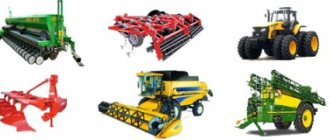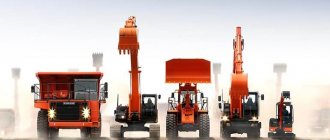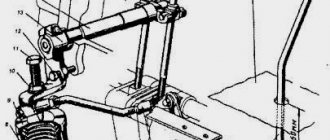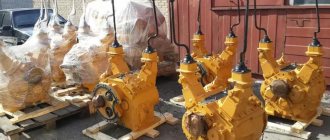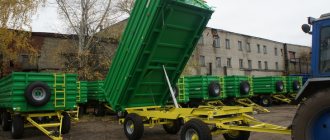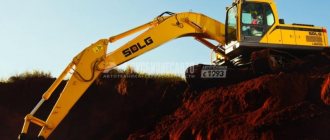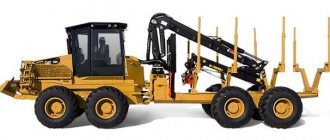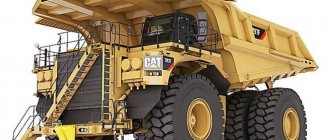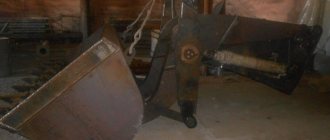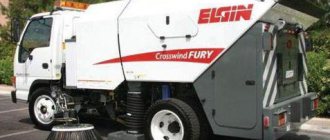Types of agricultural machines
Also check out these articles
- How to plant onion sets in spring
- The benefits and harms of pears
- Red Scarlet Potatoes
- Tomatoes with garlic
The main types of agricultural machinery should be highlighted:
- harvesting machines;
- tractors;
- sowing equipment;
- sprayers;
- feed harvesting machines;
- soil cultivation equipment.
Each type has special characteristics and functionality.
Optimizing combine operation: what do you need to know?
Regional manager of AST LLC Andrey BELOKUR:
– Where does choosing a combine harvester begin? From the definition of the threshing system. The market now offers a traditional drum, with one or two drums, a hybrid and a rotary, and the last two are often confused. In a hybrid system, threshing also occurs on the drum, but separation occurs on the rotor. The productivity of the combine increases, starting with the drum version (the quality of the resulting straw is better) and reaches its maximum with the axial rotary one.
Why do we need to know this?
Tractor units
We recommend reading our other articles
- Raspberry compote
- Strawberry variety Geneva
- The best black grape varieties
- Zucchini in tomato
Tractors are divided into tracked and wheeled types. This technique is used when traction force is required. The choice of a specific type depends on the type of soil and topography of the area. Tractors are characterized by low speed, but excellent maneuverability. This is especially true for the tracked type, which is able to go where other vehicles cannot. A wheeled tractor is used mainly on hard surfaces.
Farmers of Russia
Agricultural machinery is an indispensable assistant both during field work and at the dacha. This technique has various modifications and operating functions. High-quality agricultural machinery is primarily characterized by high quality and long service life.
Agricultural machines are used to prepare soil and plant crops. For caring for the sown area and harvesting. Agricultural machines come in several types. They are used in the following order: ~ Tillage machines - such machines make the soil loose, remove all the weeds present on it, and also level the soil surface. ~ Machines for applying fertilizers - from the name it is clear that such machines add fertilizers to the soil to increase the quality of yield. ~ Sowing machines – for correct sowing from a technological point of view, certain features must be adhered to. Uniformity, depth and other sowing norms. These types of machines are used for such functions. ~ Machines for preparing feed - animals during the stall period have the same nutritional requirements as during the grazing period. Such machines are used to prepare feed without loss of nutritional properties. ~ Irrigation machines - soil fertility and, accordingly, the amount of harvest directly depends on the water supply. Using machines to water plants, they receive root and air nutrition. ~ Chemical protection machines - such machines introduce chemicals into the soil to protect plants from diseases and all kinds of pests. ~ Grain harvesters are perhaps the most famous agricultural machines. Combine harvesters are used to harvest grains, cereals and legumes. Before the advent of combines, several machines were used for harvesting, but now all functions are included in the combine. This is an indispensable technique for harvesting grain crops. ~ Grain processing machines - to store grain, it needs to be dried and separated from various impurities. Such machines are used for these purposes.
Forage harvesters
The most popular forage harvesters are the JF-STOLL FCT 1050 ProTec series, which are equipped with a pick-up, and the JF-STOLL FCT 1350 series, which are equipped with a pick-up and traction hitch.
You need to know that the kit of such models contains knives made of the highest quality steel, a shear plate and a sharpening stone with particularly quick installation. There is also the possibility of reverse.
Such high productivity of forage harvesters of the JF-STOLL models is ensured by:
— pick-up lift is hydraulic; — a wide rotor with knives, which are located in certain sections, which facilitates their quick replacement; — expansion of the feed shafts in the grinding drum.
These types of combine harvesters can also be equipped with a corn and grass header. A huge plus is that forage harvesters of the JF-STOLL models, thanks to special cutting methods, significantly save energy resources.
The following machines have good operating qualities: the BiG X self-propelled field chopper, the XDisc straight-cut header, and the EasyFlow pick-up. KRONE forage harvesters are distinguished by high productivity, robust design, excellent quality of feed chopping, as well as comfortable operation.
The BiG X self-propelled field chopper is manufactured and developed on the basis of innovative technologies, which is why it can move much faster while using the lowest engine speeds. Due to this, quite significant fuel savings occur.
This model also has the ability to adjust the cutting length on the go.
A very significant advantage among KRONE pick-ups is the complete absence of a complex control mechanism, which reduces the number of parts for constant replacement that will be subject to rapid wear.
Such machines are used for preparing feed for cattle. According to statistics, high-yielding dairy cows consume significantly more feed than dry cows.
Experts also note that cows chew food for ten hours every day. If they are fed with coarse, crushed feed, this time is reduced to eight hours a day.
Thus, it becomes possible to meet the needs of cows for nutrient consumption and reduce the volume of concentrated feed used.
Potato harvesters
Potato harvesters are trailed units that are designed for digging potatoes from the soil and cleaning potatoes from the ground, collecting potatoes into special bins and then unloading potatoes into special vehicles.
The tubers are dug up using special diggers with a knife and a copying roller. With the help of a filter and a sorting and vegetable hill separator, the potato harvester separates the tops, soil, and weeds from the potatoes.
There are different types of potato harvesters: elevator and bunker, and also single-row or double-row.
Some models of potato harvesters are equipped with an attachment for collecting onions and carrots.
There are single-row potato harvesters of the Grimme SE 75-20, SE 75-30, SE 75-40 and SE 75/85-55 models.
Potato harvesters of the Grimme SE 75/85-55 models have the following equipment:
• undermining device from the side; • Grimme - digital technology; • A hopper with a capacity of about six tons • A receiving channel with a width of seventy-five centimeters or eighty-five centimeters.
Such units are considered the most popular potato harvesters, as they have a special digging device.
Grimme model machines are distinguished by good quality, high productivity, and careful handling of the harvest.
The potato harvester from the Grimme SE 75/85-55 series has high productivity and, accordingly, is the best option for farmers who rent out machines.
This machine was first tested during the harvest in 2005. Such technical developments, which were used in the production of the potato harvester, confirmed their productivity and were able to withstand absolutely all the necessary tests.
Another important innovation is the reduction in the fall in height of potatoes from one to the second row. This technology allows you to preserve the integrity of the root crops themselves.
Integrated tilt leveling ensures uniform screening of soil and makes work as comfortable as possible.
As additional equipment, the kit includes the supply of an inspection table, which has a much greater throughput capacity - up to eighty-five centimeters wide.
Combine harvesters
A grain harvester is a complex machine for harvesting grain (reaping-thresher), which performs simultaneously and sequentially in a continuous flow: cutting grain grains, feeding them to the threshing apparatus itself, hammering grain from the collected ears, separating it from all sorts of impurities, transporting already clean processed grain into the bunker, from where mechanical unloading will occur.
This is one of the most important and necessary machines in agriculture, which can simultaneously perform several completely different operations.
For example, such a harvester collects ears of corn, knocks out the grains from them and cleans the latter.
This complex multifunctional machine performs the functions of three simpler machines at once - a winnower, a reaper, and a thresher.
For any grain harvesting combines, special additional devices are produced, which later make it possible to harvest a variety of agricultural crops, not only grains.
Modern grain harvesters first appeared in the United States back in 1828.
Mr. Lane filed the first patent for the creation of a complex combined machine for collecting grain and more.
Such a machine would have to simultaneously perform several functions - cut the ears, thresh them, clean the grain. But the car was never built.
In one thousand eight hundred and thirty-six, Verg and Carpenter invented the first existing combine harvester. It was mounted like a cart on four wheels, and the rotation of the threshing drum was applied, driving the cutting apparatus. All this was carried out due to a certain transmission from the rear wheels of the combine.
In the same year, but a little later, Moore and Haskal won a patent for a machine as close as possible to the modern model of the combine.
Already in one thousand fifty-four, a combine of this model was used in the state of California and harvested about two hundred and forty hectares of grain.
Until the sixty-seventh year of the nineteenth century, the design and creation of such combines was carried out exclusively in the eastern part of America.
In the seventy-fifth year of the nineteenth century in the state of California, a combine designed by Peterson received much more recognition than the combines of other inventors. And at that time it became the main technique for harvesting grain.
So it was in the nineteenth century that the grain harvester began its development and became the main machine in agriculture.
Potato planter - a convenient unit for agriculture
What is this apparatus, indispensable in any agriculture? The potato planter is combined with a walk-behind tractor and is a device for planting unsprouted potatoes.
Its operating principle is as follows. The furrow is broken using a special keel-shaped beard cutter and at the same time whole or cut tubers are captured, then they are thrown into the opener, from where planting material is poured into the ground at a set pitch.
After that, special spatulas located slightly behind bury the potatoes with soil. The landing pitch is set using stars that have different diameters.
The angle between the discs in the hiller is also adjustable. Potato planters are used for uniform row planting both in pre-created ridges and for smooth planting.
Moreover, in addition to directly introducing potato tubers into the soil, it can perform some other functions, namely adding fertilizers and minerals to the soil, which will help increase productivity.
Potato planters come in different configurations, both adapted for small volumes of planting in one or two rows, and serious industrial units for four-row planting of potatoes, equipped with support-drive wheels with large-capacity bins.
The number of tubers planted in one go depends on the volume of the bunker. Some farmers have learned to make potato planters with their own hands.
These are technically different machines, however, some of them are very effective. Most often you can find potato planters for walk-behind tractors .
So, you have decided to purchase this device. First of all, you need to choose the option that is optimal for your site, depending on the planned volumes.
Caring for this machine and the operating process itself are extremely simple. Of course, it must be periodically subjected to technical inspection, possible minor repairs or replacement of parts, and for this it is better to show the potato planter to specialists at a service center.
As a rule, all major manufacturers have technical centers close to the end user, and thus you will receive both a guarantee of the quality of the work carried out on your device and the confidence that only original spare parts were used for repairs and their installation was carried out with the utmost care .
And in similar centers engaged in the sale of agricultural equipment, prices are more than acceptable. They will also help you choose the best option for you and provide free consultations on working with their equipment.
Design features of beet loaders
A beet loader is a machine for collecting beets from windrows and heaps; its tasks also include preliminary cleaning of root crops from the ground and further loading them into a vehicle.
Such cleaning of tops and soil makes it possible to increase the useful mass of root crops by 8-10% when supplied to sugar factories.
These agricultural machines are divided into mobile ones, which operate from the power take-off shaft of a tractor tractor, and stationary ones, which operate due to the engine.
The most common in the territory of the former USSR are mounted mobile beet loaders; they are mounted on a medium-sized tractor equipped with a creeper.
They, in turn, are divided into units of periodic and continuous operation. Those that operate on a continuous principle are equipped with a picking mechanism, the so-called “feeder” of the rotary type, as well as bar cleaning conveyors.
The most famous are the SPS 4.2 beet loaders of various configurations.
The batch loader has a screw cleaner and a rake type feeder.
The feeder operates as follows: it picks up root crops from the heap and directs them to a longitudinal conveyor, from where they enter the transverse conveyor belt, and then to the loading elevator.
From the elevator, beets are dumped into the back of a vehicle traveling nearby. Another type of beet loader is self-propelled and structurally consists of a self-propelled chassis with a frame on which the tractor is located with the drive wheels and hydraulic speed reducer removed, rear suspension and front axle mechanisms, front pneumatic drive wheels and a manual control mechanism.
In addition, there is a rotary cam feeder, with the possibility of active removal using a beater shaft equipped with rake flaps, as well as support wheels; receiving screw conveyor; longitudinal rod-type conveyor with scrapers; auger cleaning device, represented by a biter root spreader, a feeder and an auger cleaner; unloading rod elevator with scrapers; transmissions from the tractor PTO; hydraulic systems; feeder lifting block; containers for counterweights; automatic load controller and electrical equipment.
As a rule, the standard working width of this unit ranges from 2.1 to 3.3 m, which is very convenient, and with such a grip the average productivity is 50 - 60 t/h.
Loading can be carried out to a height of up to three meters, and the beet loader moves at a speed of 0.25 km/h.
To service a standard beet harvester, a tractor driver and one or two workers are required.
Features of operation of potato diggers or potato harvesters
Potato diggers or potato harvesters are multifunctional technical complexes that are designed for harvesting potatoes using a mechanized method, which involves separating tubers from tops, soil and plant impurities, followed by accumulation of the harvested crop in a special bunker and unloading into a vehicle driving nearby.
Before launching potato harvesting equipment into the field, it is necessary to collect the tops of the plants, namely, use a tops harvester, or remove them in another possible way.
Potato diggers or potato harvesters are divided into two categories: mounted and trailed.
Actually, mounted ones are called potato diggers, and trailed ones are a full-fledged potato harvester.
Farmers prefer to use potato diggers for walk-behind tractors , since the walk-behind tractor is a multifunctional device and is an indispensable assistant for farming.
Decide for yourself which of these types of devices you choose, depending on the planned volume of work and the cost-effectiveness of the work.
Let's take a closer look at each of these categories. A mounted potato digger is placed on the attachment of a row-crop wheeled tractor.
Its basis is the body (frame), which is about two meters long and reaches one meter wide.
The frame rests on pneumatic roller wheels at its rear. The lower front part of the potato digger is usually equipped with two knives, which are oriented forward and slightly angled towards the ground.
They move back and forth in their plane in order to enter the soil to a depth of approximately 15 - 20 cm, due to the movement of the tractor and their own, to capture and transfer the layer of soil containing the tubers to the top.
There they fall onto a conveyor consisting of small-section metal rods, the gap between which is about 2–3 cm.
Moving further up the conveyor, the soil and small remains of vegetation fall into the gaps, and the tops are separated from the root crops and fall out onto the ground at the exit from the conveyor belt.
Naturally, this is followed by manual harvesting of the tubers. The blades and conveyor are driven by the tractor PTO.
Many Russian farmers have learned to make potato diggers with their own hands . Such devices are in no way inferior to their factory brothers.
The potato harvester is a design almost similar to the potato digger described above, identical conveyor and knives, but supplemented with means for cleaning root crops and their separation.
It is also equipped with a special hopper for tubers. A trailed machine is significantly larger in size than a mounted one - about four meters long and two meters wide.
Its rear axle rests on the wheels, and the front axle rests on the tractor's coupling device. The drive of the working parts also comes from the tractor PTO.
Beet seeders for farms
Beet seeders are used for dotted sowing of pre-calibrated beet seeds, as well as for simultaneous application of mineral fertilizers.
Often, with the help of simple accessories, such a seeder can be easily modified for planting seeds of millet, beans, soybeans and buckwheat.
As a rule, they are divided into two types according to the row spacing: for 45 cm, which is suitable for the main rain-fed areas for growing beets, and for 60 cm for areas with irrigated beet sowing, on peat bogs and in places of high moisture.
Beet seeders are aggregated with tractors of class 1.4 - 2 traction type . The operating technology of such a seeder is identical to the operation scheme of universal pneumatic seeders. But there are a number of differences, which we will dwell on in more detail.
First of all, this is the vertical arrangement of the discs in the sowing units of the sections.
Moldboard harrows are equipped with hinged wings; they are held at a given depth using spring-loaded rods.
The beet seeder train consists of round bars with side wings, which are connected to each other by chains.
The right foot board has a track former which is used to lay furrows between rows so that pre-emergence treatment of crops can subsequently be carried out.
The sowing rate of beet seeds can be adjusted by changing the disk rotation speed and the number of cells directly on it.
As a rule, all models are equipped with several sets of discs for seeds of different fractions; the depth and diameter of the cells also vary.
In most cases, the disks have three rows of cells, but on small farms with low seeding rates, it is advisable to overlap two rows using a special sector, leaving only one for the workers.
The rotation speed of the seed disc can be changed by installing the gear chain on the desired sprockets.
Some modifications of beet seeders are equipped with a device for applying, in addition to granular mineral fertilizers, also liquid fertilizer.
Fertilizers are supplied through fertilizer lines to the front part of the opener with an opener, which has a skid-like shape, cutting a furrow for fertilizers. For this reason, fertilizers are located on the side of the seed, separated from it by a layer of earth. And all devices, without exception, are equipped with a control system over the level of planted seeds and the sowing technological process.
A wide range of beet seeders are presented on our market; it will not be difficult for owners of agricultural enterprises to choose the option that is optimal in terms of price and performance.
Topper harvesters for large agricultural enterprises
This machine is a device for cutting and then crushing the tops of agricultural crops, in particular potatoes, beets, and low-growing forage crops.
The topping machine is aggregated with tractors of class 1.4 - 2. Most modern models can be aggregated both front and rear.
The most famous and used models among farmers in Russia are: BM 6, BM 6A, BM4 . The operating principle of this device is as follows.
With the help of a rotating beater, the tops are cut, crushed and thrown into the auger, which, in turn, delivers the incoming tops to the thrower. The beater has segmented and solid-toothed active disc knives, as well as passive copiers.
Then the thrower, through its blades, throws the resulting mass into a pipe, which has an outlet into a special bunker, and then it is unloaded by a scraper conveyor into a vehicle moving nearby.
Conveyors installed on such machines are, as a rule, of the rod type. Precise placement is ensured by the rotor housing guide plates.
Options for laying tops in windrows are also possible. The whips of the topping machine are protected from encountered stones, as they can move freely in the direction of the fastening axis. Most devices have root head cleaners and electrical equipment for operation at night.
Also, it is mandatory that any leaf removal machine is equipped with a reliable control system that monitors the uninterrupted operation of the rotating units. The working parts of the unit are driven by the power take-off shaft of the tractor, and it moves on wheels.
Some models are compatible with potato and root harvesting machines, which, as you can imagine, greatly simplifies and speeds up harvesting.
Tops harvesting machines are indispensable on large farms, since at such volumes, harvesting and processing tops of agricultural crops is a very labor-intensive and expensive process.
There are many different models of such units on the modern market, which differ in size, power, and, accordingly, productivity, which averages 1 - 1.6 hectares per hour.
The speed of the topping machine ranges from 4 to 6 km/h.
Most manufacturers guarantee up to six years of uninterrupted operation of this device, which is a good indicator in terms of the cost-effectiveness of using this machine.
SPRAYER
We all know that without proper care of plants, whether on a personal plot or in a large farm, we cannot expect a good harvest or beautiful flowers.
Moreover, care must be taken in a timely manner, taking into account both weather conditions and the characteristics of the crops grown.
The application of fertilizers, as well as the fight against parasites, are no less important than high-quality watering of plants.
For these procedures, special garden sprayers , designed for spraying both liquid substances and powder analogues.
Depending on the size of the area being processed, the type, as well as the power and dimensions of the unit are selected.
They come in manual versions, which are ideal for working on a summer cottage and in your garden, backpack and petrol, designed for processing large areas.
Backpack sprayers are an improved version of hand sprayers; they are equipped with a reliable pump, the pressure in which is ensured by several light strokes.
The mixture sprayed in this way falls not only on the surface of the plants, but also on the upper part of the soil, which provides more reliable protection and efficiency of the working mixture.
In addition to applying fertilizers and chemicals, hand and backpack sprayers can also be used as blowers and used when it is necessary to dry plants after rain or to prevent large accumulations of moisture, which will contribute to soil acidification and plant rotting.
When watering with a sprayer, an optimal level of humidity is achieved directly above the ground, as well as a decrease in air temperature near the root system of plants.
Modern gasoline versions have improved engines that provide minimal exhaust emissions, fuel economy and performance that can satisfy the most critical owner.
In addition, sprayers can be either manual or self-propelled, which, you see, is very convenient for huge volumes of serious farming.
And you shouldn’t think that this device is applicable exclusively for the garden; with its help you can fight parasites in warehouses, in places where animals are kept, namely in stables and paddocks, as well as in carriages and on ships.
In a word, we tried to most accurately and in detail describe all the functionality and advantages of using the sprayer, both for industrial and domestic purposes, all that remains is one small thing - you need to decide on the brand of the device and purchase it!
Beet harvesters for harvesting sugar and fodder beets
Beet harvesters are designed for economical and highly efficient mechanized harvesting of sugar beets, both mother and factory, as well as fodder beets in irrigated and main beet planting areas using transshipment and flow methods.
They come in two types: trailed and self-propelled ; Based on the types, they are divided into digging and terminating .
The principle of operation of such a combine is as follows: the roots of plants are dug up, removed from the soil, then the tops are cut off, and the root crops themselves are loaded into the bodies of vehicles traveling next to the combine.
The tops are poured into a tractor cart, which is coupled to the combine.
Structurally, the combine harvester consists of the following parts and blocks: a digging paw, which destroys the connection between the roots and the soil; cardan transmission from the power take-off shaft, which drives the working parts; a mechanism operating on the principle of hydrotracking to guide the unit along the rows; copy wheel; a loading-type elevator designed to direct root crops into the body of the car; lifting apparatus for extracting beets from the ground; cutting block for separating roots from tops; conveyor for root crops; a conveyor that unloads the tops into a tractor cart; the tractor trolley itself; auger cleaner for cleaning tubers from soil and plant impurities; automobile.
Some models of beet harvesters are equipped with several replaceable diggers - disk, fork or vibration type, which allows increasing efficiency in different soil and climatic conditions.
The ability to choose from one to six row combines ensures optimal adaptation to the size of the area being processed, as well as significant cost savings.
Bins are also available in different sizes.
The cleaners are adapted for both gentle cleaning of collected root crops in dry conditions, and intensive cleaning in wet conditions.
There are models of beet harvesters that not only harvest sugar beets, but are also adapted for harvesting carrots, table beets and other large root crops.
Recently, combine harvester manufacturers have been gravitating towards making the unit as light as possible in order to reduce pressure on the soil.
Such machines easily process up to three hectares of plantings per hour.
Of course, it is better to purchase such equipment at the sales centers of its manufacturers, so in addition to a quality guarantee for the combine, you will receive its mandatory maintenance and repair with the installation of original spare parts, which, believe me, is very important.
Use of thinners in agriculture
Thinning machines are used to thin out sugar beet seedlings along planting rows. This process is carried out at the moment when 1 - 2 leaves of the plant hatch, and it must be done no later than a week and a half after that.
Due to the relatively low germination of the seeds of this agricultural crop, its sowing occurs in a dotted manner with a small margin - the row spacing is from 45 to 60 cm, the distance directly between the seeds is about 5 - 12 cm.
Sometimes the work of thinning seedlings is entrusted to ordinary cultivators, but in this case, in addition to the need for additional manual work, there is an even greater threat of the death of a significant part of the plants under the wheels of the tractor.
Therefore, of course, on large farms it would be optimal to use specially designed automatic or mechanical thinners.
In mechanical thinners, the knives rotate due to the rotation of support-drive wheels - sections operating on pneumatics.
The knives themselves are located on the head, the torque of which is transmitted from a bevel gearbox. The head is located at an angle of 40 degrees in relation to the direction of movement of the machine.
The number of knives can be varied from 6 to 18, due to which the length of the bouquets can vary from 50 to 150 mm.
They can be arranged in threes, twos, or one at a time. You can find out the required number of knives using the special table included with the machine, based on the average number of shoots per 1 m of row.
The stroke depth is adjusted by rotating the gearbox housing relative to the axis of the support wheel.
The automatic thinner is equipped with knives that are driven by hydraulic motors with electromagnetic spools.
The spools are turned on using a command coming from an electrical computing unit, which operates due to electrical impulses from two sensors that monitor the operation of the knives and detect plants.
The knife cuts off excess plants that have sprouted before the control seed detected by the sensor. And the second knife, located behind the structure, loosens the soil and removes plants that have grown behind the control one.
The only difficulty in using thinning agents is the requirement that among the crops there should be no weeds that have the same height as the seedlings, and there should be no lumps on the soil surface that protrude more than two cm.
The device itself operates using electricity supplied from the tractor and is also equipped with an autonomous hydraulic system.
Row-crop cultivators for gardens and field work
The task of row-crop cultivators is to apply mineral fertilizers, compost and peat for plants, as well as for hilling crops grown in household plots.
They are indispensable for uniform and high-quality loosening of the soil. For this purpose, the cultivator is equipped with a special mechanism, with the help of which even heavy soil that is difficult to cultivate is easily loosened, and the root system of weeds is trimmed.
It creates optimal conditions for air and water to enter the soil. Also, with its help, it is possible to dig furrows between the rows for watering and hilling.
The depth of fertilizer application is adjustable; as a rule, the optimal level is 8–16 cm.
The row-crop cultivator does not provide the possibility of changing attachments for the purpose of carrying out other agricultural work.
This device, depending on the weight and engine power, can be classified into three subtypes: light, medium and heavy.
The light version is indispensable for a small summer cottage; as a rule, it is of a manual type and is applicable for both inter-row and continuous passage, and the heavy one, accordingly, is intended for long-term use on large farm fields.
Also, considering the method of powering the engine, gasoline and electric cultivators are distinguished.
Gasoline engines, of course, are noisier and more complex than their electric counterparts; in addition, their maintenance requires the constant purchase of fuel and oil, as well as increased attention to its level and cleaning of air filters.
True, for large areas they are certainly preferable, since they are independent of power supply. In any case, as you yourself understand, the more carefully you take care of your equipment, the longer and better it will serve you.
The dimensions of the unit are also an important characteristic; it is clear that for a small farm, transporting a bulky cultivator can be problematic.
Another point that needs to be decided is the working width, which is responsible for the depth of entry into the ground.
It is better to purchase a row-crop cultivator in specialized centers of manufacturers, thus, you will be provided with warranty service, and in the event of a breakdown or replacement of any parts, original components will be installed on your device.
So, decide on the brand and type and, have no doubt, the savings in effort and time are worth the cost of such a housekeeping assistant.
How to choose a seeder for noutil?
Head of the peasant farm Alexander PLOTNIKOV:
– When you buy a seeder for direct sowing, you need to focus solely on the needs of your farm and the existing conditions, and not on the recommendations of the sales manager. For example, they often offer to buy anchor seeders. You choose one, and then when sowing problems begin: it becomes clogged and collects straw. It turns out that the combine is not suitable - it chops the straw too much. So what's now? Should I change my combine or seeder? Or criticize technology? Usually they do the latter.
A seeder is just an element of technology, but it is extremely important and expensive. Making a mistake when buying it is very sad. I know farms that rearmed two or three times because of this.
When I bought a seeder, I studied my climate zone, the amount of precipitation, the type of combine... And I came to the conclusion that it must fulfill four requirements:
1. Cut up any plant debris. That is, the anchor does not suit me, only the disc seeder. Having decided on this, I immediately abandoned the chopper on the combine. I removed it and installed a whirlpool spreader. Unchopped straw is distributed across the width of the header. What have I achieved? The larger the crop residue, the easier it is for the seeder to cut it. And then, they cover the soil surface better, so more moisture remains in the fields.
2. Place the seed in the ground to the required depth: if you need four centimeters, then exactly four. Six means six. I work with small seeding rates, and this is important to me. In this case, the depth control on the seeder should be located directly on the sowing coulter. I had experience with a unit where the control was located at the rear, on the press wheels. I could not achieve a clear location of the seed.
3. Create close contact between the seed and the soil. This is necessary so that the plants are in the same development phase. If there is no contact with the soil, then it turns out like this: some sprouted, while others did not. Tiering is unacceptable.
4. Close the furrow. They cut the soil, put in the seed, and immediately closed the furrow. My seeder does this. At the rear it has a press wheel with adjustable pressure and angle of attack.
Let me emphasize: you need to choose a unit for your specific conditions! And the quality and speed of service is also important. If something is broken and they tell you: “We’ll fix it in a week,” then you’ll waste time. For me, in this sense, the SPS-6 seeder produced by Agropromtekhnika JSC was ideal. It suits me from the point of view of both agricultural technology and service.
Tractors
According to the results of a study conducted by , the most popular tractors in Russia are those produced by the Minsk Tractor Plant (MTZ). MTZ tractors accounted for 56% of all surveyed tractors purchased since 2012. In second place are the Kirovets tractors, produced by the St. Petersburg Tractor Plant, and in third place are John Deere. Collectively, the Top 3 major tractor brands account for 85% of all tractors surveyed (Graph 2).
Graph 2. Top 5 popular tractor brands in Russia, % of the number of equipment units covered by the study
Among MTZ tractors, the most popular is the MTZ 82, among PTZ tractors the Kirovets 744, and among John Deere tractors the 7830 model. The first two tractor models are in great demand among individual farms, while John Deere is in great demand among agricultural holdings.
Another
TOL Tree trimmer
- Agricultural robots
- Allen Scythe
- Aquatic weed harvester
- Feed chopper
- Bale separator
- Mixer car (Feeder for diet)
- Cooling
- Pipeline analyzer
- Brush cutter
- Hedge trimmer
- Livestock trailer
- Mulching machine
- Postal Driver (and Hand Tool)
- Shear gripper (and power supply)
- Trailer
- Yard Scraper
Tillage
Harrows in use in 1948. Canterbury Agricultural College farm
- Cultivator (of two main variations) Extended teeth (also called shanks) that pierce the soil.
- Rotational movement of discs or teeth. Examples: Power cultivator / Rotary cultivator / Rototiller / Bed linen cultivator / Mulch cultivator / Rotavator
called Zone before subsoiler)
Features of choosing and setting up a combine harvester
Traditional model combines are relevant for those farms where small areas need to be harvested. Axial-rotor and hybrid systems are more productive, so they are more often purchased by holdings, as well as farms with crops such as corn and peas. This is due to the fact that greater grain crushing occurs on the drum. On the rotor – gentle mode, crushing up to 0.7%.
When you have chosen a combine, you need to configure it correctly - productivity, amount of losses, grain crushing, total losses in rubles depend on this... Even on a conditional 600 hectares, they can reach hundreds of thousands of rubles.
Michal Jankowski, Head of New Holland Forage Equipment in Asia, Africa, Mexico and the Middle East: “New Holland’s global dealer network and commitment to excellence guarantee the highest level of service and uninterrupted supply of original spare parts for every customer.”
How to achieve maximum productivity on a drum harvester with a straw walker? Set the optimal drum speed and reduce the thresher clearance. In a rotary combine, the situation is the opposite - here you need a maximum gap between the rotor and the threshing drum. In this system, threshing occurs due to mass friction.
Electrical equipment on farms
The main purpose of the devices and units of this group is, of course, to provide farms with electricity. The following types of equipment of this type can be used on farms:
- electrical;
- ballast;
- control and measuring;
- automation tools;
- lamps, etc.
Without such devices and units on the farm, it will be impossible to arrange ventilation, provide lighting, and operate milking machines. Without separators you cannot make cream and butter, without refrigerators you cannot store milk, etc.
How to choose the right diesel fuel for agricultural machinery?
Head of the department for testing tractor units and fuels and lubricants of the North Caucasus MIS Sergey OLDYREV:
– There are a large number of players on the market offering to buy both large quantities of fuel and small ones. And the quality of many, according to our observations, leaves much to be desired.
How should you choose fuel? First, open the operating manual for your combine or tractor - it will clearly indicate what kind of fuel you need to fill a particular engine with. Recently, almost all instructions regulate the use of EURO-5 quality diesel fuel. You can find it, but it is expensive. And sellers often sell low-viscosity marine fuel under the guise of expensive fuel. It is not recommended for agricultural machines - fuel systems will fail faster. To check the fuel, remember only four indicators (there are two dozen of them in the passport, but to figure it out, four are enough): these are the fractional composition, density, sulfur content and flash point. They will show whether the fuel is good or not.
The same goes for engine and transmission oils. There are also four important indicators here. They can be examined in any accredited laboratory (we also do this): alkaline number, sulfate ash content, acid number and content of mechanical impurities. Do an analysis in advance so that you don’t overpay for expensive equipment repairs later.
